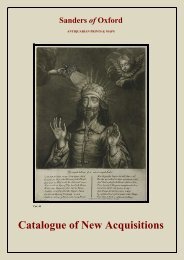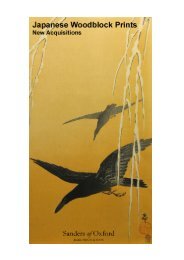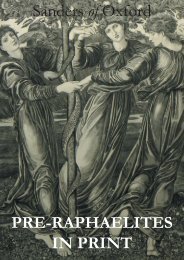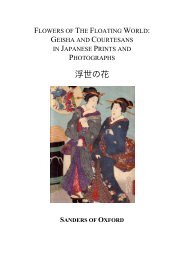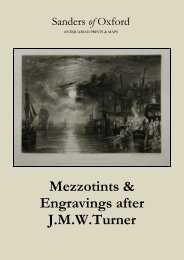catalogue text.indd - Sanders of Oxford
catalogue text.indd - Sanders of Oxford
catalogue text.indd - Sanders of Oxford
Create successful ePaper yourself
Turn your PDF publications into a flip-book with our unique Google optimized e-Paper software.
French and German edition <strong>of</strong> the Theatrum Orbis Terrarum were published in 1572, and a further twenty-five editions<br />
were printed before Ortelius’ death in 1598. As well as a cartographer, whose stunning works contributed heavily<br />
to advances in sixteenth-century cartography, Ortelius is also remembered as a prophet, as he was the first person to<br />
propose the theory <strong>of</strong> continental drift in his Synonymia Geographica, 1578.<br />
John Speed (1552 - 1629) is the most famous <strong>of</strong> all English cartographers primarily as a result <strong>of</strong> The Theatre <strong>of</strong> the<br />
Empire <strong>of</strong> Great Britaine, the first atlas <strong>of</strong> the British Isles. The maps from this atlas are the best known and most<br />
sought-after <strong>of</strong> all county maps. The maps were derived mainly from the earlier prototypes <strong>of</strong> Christopher Saxton<br />
and Robert Morden but with notable improvements including parish “Hundreds” and county boundaries, town plans<br />
and embellishments such as the coats <strong>of</strong> arms <strong>of</strong> local Earls, Dukes, and the Royal Household. The maps are famed<br />
for their borders consisting <strong>of</strong> local inhabitants in national costume and panoramic vignette views <strong>of</strong> major cities and<br />
towns. An added feature is that regular atlas copies have English <strong>text</strong> printed on the reverse, giving a charming description<br />
<strong>of</strong> life in the early seventeenth century <strong>of</strong> the region. The overall effect produced very decorative, attractive<br />
and informative maps.<br />
For the publication <strong>of</strong> this prestigious atlas Speed turned to the most successful London print-sellers <strong>of</strong> the day, John<br />
Sudbury and George Humble. William Camden introduced the leading Flemish engraver, Jodocus Hondius Sr. to John<br />
Speed in 1607 because first choice engraver William Rogers had died a few years earlier. Work commenced with the<br />
printed pro<strong>of</strong>s being sent back and forth between London and Amsterdam for correction and was finally sent to London<br />
in 1611 for publication. The work was an immediate success and the maps themselves being printed for the next<br />
150 years.<br />
Speed was born in 1552 at Farndon, Cheshire. Like his father before him he was a tailor by trade, but around 1582 he<br />
moved to London. During his spare time Speed pursued his interests <strong>of</strong> history and cartography and in 1595 his first<br />
map <strong>of</strong> Canaan was published in the “Biblical Times”. This raised his pr<strong>of</strong>ile and he soon came to the attention <strong>of</strong> poet<br />
and dramatist Sir Fulke Greville a prominent figure in the court <strong>of</strong> Queen Elizabeth. Greville as Treasurer <strong>of</strong> the Royal<br />
Navy gave Speed an appointment in the Customs Service giving him a steady income and time to pursue cartography.<br />
Through his work he became a member <strong>of</strong> such learned societies as the Society <strong>of</strong> Antiquaries and associated with the<br />
likes <strong>of</strong> William Camden Robert Cotton and William Lambarde. He died in 1629 at the age <strong>of</strong> seventy-seven.<br />
Publishers<br />
The lithographer and publisher Rudolph Ackermann was born in Saxony in 1764. He moved to London in 1787 and<br />
later established a business as a coachmaker at 7 Little Russell Street, Covent Garden. In 1796, having already published<br />
the first <strong>of</strong> many books <strong>of</strong> carriage designs, he moved to 96 Strand where he ran a drawing school for ten years.<br />
The following year, Ackermann moved to 101 Strand (known, from 1798, as The Repository <strong>of</strong> Arts) where he sold<br />
old master paintings and artists’ supplies as well as prints. In 1803, 220 Strand was given as his address in a print<br />
published that year. The Microcosm <strong>of</strong> London (1808-10) and the monthly Repository <strong>of</strong> Arts (1809-29) established<br />
his reputation for fine colour plate books. From 1816, he began to publish lithographs. Ackermann always maintained<br />
links with his native Germany, and in the 1820s, he also opened outlets in Mexico, Guatemala, Colombia, Argentina,<br />
and Peru. In 1832, he handed the running <strong>of</strong> the business over to his second son George and his younger brothers, who<br />
traded as Ackermann & Co.at 106 The Strand until 1861. Ackermann also established a print business for his eldest<br />
son Rudolph at 191 Regent Street.<br />
John Browne (1741 - 1801) was an English engraver and publisher. The son <strong>of</strong> a Norfolk clergyman, Browne was<br />
educated in Norwich, and in 1756 was sent to London, where he was placed with John Tinney the engraver. William<br />
Woollett was his fellow apprentice. Browne’s reputation grew in 1768 when he exhibited the engraving ‘St. John<br />
Preaching in the Wilderness’, after Salvator Rosa. In 1770 he was made an associate engraver <strong>of</strong> the Royal Academy.<br />
Browne is best-known as an engraver <strong>of</strong> landscapes, which were <strong>of</strong>ten published by John Boydell.<br />
The firm <strong>of</strong> Day & Haghe was one <strong>of</strong> the most prominent lithographic companies <strong>of</strong> the nineteenth-century. They<br />
were also amongst the foremost pioneers in the evolution <strong>of</strong> chromolithography. The firm was established in 1823 by<br />
William Day, but did not trade under the moniker <strong>of</strong> Day & Haghe until the arrival <strong>of</strong> Louis Haghe in 1831. In 1838,<br />
Day & Haghe were appointed as Lithographers to the Queen. However, and perhaps owing to the fact that there was<br />
never a formal partnership between the two, Haghe left the firm in the 1850’s to devote himself to watercolour painting.<br />
The firm continued as Day & Son under the guidance <strong>of</strong> William Day the younger (1823 - 1906) but, as a result <strong>of</strong><br />
a scandal involving Lajos Kossuth, was forced into liquidation in 1867. Vincent Brookes bought the company in the<br />
same year, and would produce the caricatures for Gibson Bowles’ Vanity Fair magazine, as well as the illustrations for




